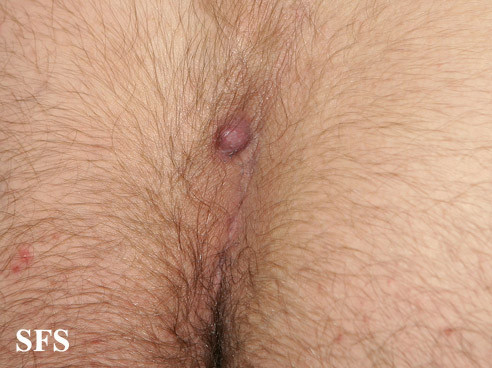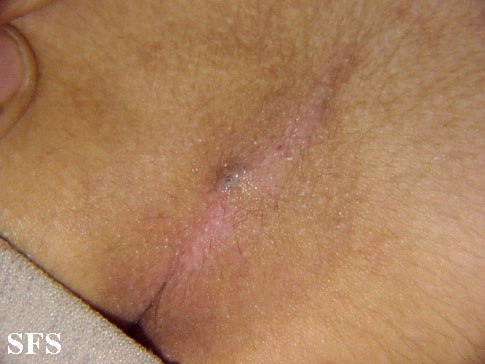Pilonidal Cyst (Abscess) Disease
What is pilonidal disease?
Pilonidal disease is a a recurrent or persistent infection of the skin and underlying tissue at the top of the cleft of the buttocks (crease or “crack”). The infection leads to the formation of a cyst, abscess or long passages (sinus tracts). Due to its chronic nature in some people, the condition is referred to as pilonidal disease. Pilonidal disease is mainly seen in males. It is a painful condition that can lead to severe infections if not treated and managed properly.
Reasons for Pilondal Disease
The sex hormones have a major effect on the hair follicles and sebaceous glands (pilosebaceous unit). The rise in the hormones with puberty causes various changes in the skin by impacting on the pilosebaceous unit. This is seen for example in acne vulgaris (teen pimples). However, other conditions can also start with the changes in the sex hormone levels in the body.
One of these is in the area at the top of the cleft of the buttocks, commonly referred to as the buttock crease or colloquially as the “crack”. The hair follices here become clogged with keratin, the skin protein, due to the influence of the sex hormones. This blocks the outlet for the sebaceous (oil-producing) glands of the skin. The follicle becomes swollen and prone to an infection.
Pilondial Abscess
Infection of the clogged follicles which extends to the tissue under the skin (subcutaneous tissue) causes abscess formation. An abscess is a collection of pus confined within otherwise healthy surrounding tissue. Eventually this abscess ruptures and forms a deep tract extending further into the body.
Pilondial Cyst
The terms pilonidal abscess and pilondial cyst are often used interchangably. However, a cyst and abscess are different – an abscess contains pus while a cyst is a fluid-containing cavity that sometimes even has semi-solid material. Therefore in pilonidal disease, a cyst can form and is not an abscess. It is referred to as a pilonidal cyst. These cysts may contain collections of hair and debris. It can progress to form into a sinus tract.
Pilonidal Sinus
The deep tract formed after the abscess ruptures develops in the direction of hair growth. It is referred to as a pilonidal sinus, or more correctly a sinus tract. It can eventually communicate with the cleft of the buttock and provide an opening for the pilonidal abscess to drain through. An sinus tract can serve as site for loose hairs to become trapped within, and can then become inflamed or even infected. This becomes a source of recurrent or persistent irritation or infection which is essentially the chronic condition referred to as pilondial disease. Sometimes even non-human foreign bodies can get trapped within the sinus tracts.
Signs and Symptoms
The two main symptoms are pain and discharge. Other symptoms such as fever, redness and swelling at the site are variable. Malaise and nausea are rare symptoms of a very severe infection.
Pain
An abscess is painful. Generally, the larger the abscess, the greater the pain. The area is typically tender to firm pressure, red and swollen with a lump palpable under the skin. However, even before the formation of an abscess, infection of the follicle (folliculitis) or subcutaneous tissue (cellulitis) will also present with pain and tenderness. In some bases the pain may be reported at lower back pain. An uninfected cyst is usually not painful despite the condition being present.
Discharge
A pustular discharge may be present. It is yellow to brown and typically has a foul odor. The discharge may form crusts at the site which the patient peels. Alternatively the crusting may be sometimes mistaken for fecal remnants and reported as such by patients. When an abscess starts draining through a sinus tract, the pain may ease slightly compared to an abscess that is enlarging and has no outlet.
Causes and Risk Factors
A pilonidal abscess is a consequence of infection. A pilonidal sinus tract and cyst develops after the abscess resolves as the pressure created by the pus within the abscess causes the formation of cavities (cysts) and channels (tracts). However, the underlying mechanism apart from changes in the pilosebaceous unit with sex hormones, seems to be due to multiple factors.
Firstly, pilondial disease is much more common in men than women. This may be due to thicker and coarser body hair than compared to women and can also be a result of the differences in sex hormone levels between the genders. It is also more common in younger and more hairy men, typically White males rather than African or Asian males. Differences in hair structure and other characteristics among the races may be a major factor to the development of pilonidal disease.
Secondly, various risk factors have been identified although the exact role of these factors are not always clearly understood. These risk factors include :
- Poor personal hygiene
- Obesity
- Prolonged sitting
- Repeated friction on the buttock
- Excessive sweating especially around the buttock region
- Injury to the buttock
Pilonidal Cyst Pictures
These pictures have been sourced from Dermatology Atlas Brazil courtesy of Samuel Freire da Silva, M.D.
Treatment of Pilonidal Disease
Physical examination will usually reveal the presence of an abscess or pit which is the opening of the sinus tract. Surgery is necessary for both treating the acute condition and to close the sinus tracts to prevent further recurrence in chronic pilonidal disease.
- In the acute setting there is an active infection. The pilonidal abscess should be incised and drained.
- Chronic pilonidal disease requires more aggressive measures to close the sinus tract. This can be achieved with repeated phenol injections that sterilize the tract. Curetting (surgical scraping) removes any hair or other foreign material in the tract. The sinus is then surgically removed (excised).
- In complex pilonidal disease, a wider excision is necessary to remove the tract. This wide excision then requires a closure flap to seal the area. However, a closure flap is more likely to develop complications like infections.
References :
http://emedicine.medscape.com/article/192668-overview
http://www.webmd.com/skin-problems-and-treatments/pilondial-cyst






